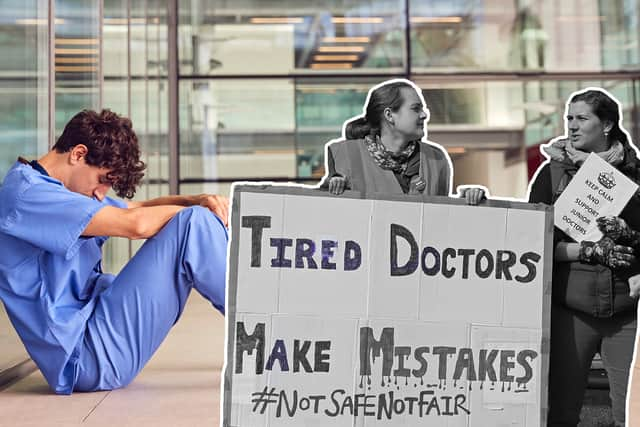Junior doctors: 40% plan to leave NHS over pay and conditions as BMA ballots for strike action
and live on Freeview channel 276
Thousands of junior doctors are planning to walk away from their NHS jobs, a new poll suggests, as the threat of strike action looms.
A survey revealed that 40% of junior doctors plan to leave the health service as soon as they can find another role, with pay and poor working conditions cited as the main reasons for wanting to leave. Junior doctors were only given a 2% pay rise in 2022, despite inflation consistently hitting double figures.
Advertisement
Hide AdAdvertisement
Hide AdThe British Medical Association warned that the NHS “would not be able to cope” without two fifths of its junior doctor workforce. Meanwhile, a third (33%) of the 4,500 junior doctors in England surveyed said they were planning to work in another country in the next year, with Australia and New Zealand as the top destinations.
It comes ahead of an industrial action ballot of junior doctors in England, which will open on Monday 9 January. Some 45,000 doctors will be balloted in the row over pay. Junior doctors are qualified doctors in clinical training at a hospital or in general practice. Medics can be junior doctors for up to eight years in hospital or three years as a GP, before becoming consultants.
Paramedics and nurses have already taken strike action this month. If junior doctors voted to walk out, it would be their first strikes since 2016 during a dispute with the then Health Secretary Jeremy Hunt. Those were the first strikes for 40 years.


The BMA said that pay for junior doctors has fallen by more than a quarter in real terms since 2008/09. BMA chair of council, Professor Phil Banfield, said: “The situation is severe. A third of junior doctors are planning to work in another country. Four in ten say that as soon as they can find another job, they will leave the NHS.
Advertisement
Hide AdAdvertisement
Hide Ad“The health service will simply not be able to cope. For decades the NHS was the envy of the world. But without our doctors’ expertise, the country will get sicker. We will not accept impoverished healthcare for our nation, or acquiesce to those looking to slash pay and drive down living standards for NHS staff. In 2023 we will stand together with patients, an organised workforce ready to act.”


Dr Vivek Trivedi, co-chair of the BMA junior doctors committee, said: “These figures are hugely concerning. If our government doesn’t act now, it doesn’t take a genius to see where this will lead: an exodus of junior doctors to foreign countries, with the ones who stay in the NHS facing an ever-increasing workload – until they feel they have no option but to leave too or get burnt out.
“If the government wants ‘move to Australia’ to stay off the New Year’s resolution lists of junior doctors this year, it is going to have to start by reversing the 26% real terms pay cut they have endured since 2008 – or at the very least start speaking with us and stop ignoring our repeated calls to address our pay.”
A Department of Health and Social Care spokesperson said: “The Health and Social Care Secretary has been clear that supporting and retaining the NHS workforce is one of his key priorities, and that includes our hardworking junior doctors. Our multi-year pay deal with the British Medical Association is increasing junior doctor’s pay by a cumulative 8.2% by 2023.
Advertisement
Hide AdAdvertisement
Hide Ad“We have also invested an additional £90 million to provide the most experienced junior doctors with higher pay, increased allowances for those working the most frequently at weekends, and increased rates of pay for night shifts. There are record numbers of staff working in the NHS, and we are committed to publishing a comprehensive workforce strategy next year.”
Comment Guidelines
National World encourages reader discussion on our stories. User feedback, insights and back-and-forth exchanges add a rich layer of context to reporting. Please review our Community Guidelines before commenting.
